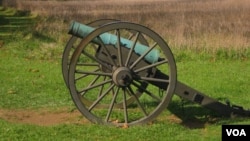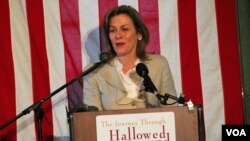As the U.S. commemorates the 150th anniversary of the Civil War, a new project is underway to honor the more than 620,000 soldiers who died in the conflict. It’s called the Living Legacy Project.
Cate Magennis Wyatt said Americans must not lose their sense of history.
“You can’t erase our past. We can’t just take for granted that the stories of those who came before us will be remembered. And if you lose the beginning of your story, you certainly have a much more difficult time bringing the original ideals of America to fruition,” she said.
Magennis Wyatt is founder and president of the Journey Through Hallowed Ground Partnership.
She said, “The Journey Through Hallowed Ground Partnership is a non-profit organization that we created in 2005 to raise awareness of the unparalleled history, heritage and culture that’s found in the swath of land from Gettysburg, Pennsylvania, down through Maryland and culminating at Thomas Jefferson’s Monticello in Virginia.”
Monticello is the name of the home of the third U.S. president.
Magennis Wyatt said the nearly 290 kilometer, or 180 mile, stretch of land is like no other.
“There’s more American history and heritage in this swath of land than any other place in the country. And in 2005, the same region was declared one of the 11 most historically endangered places in the country by the National Trust. It lies just on the edge of Washington, D.C., and in measureable terms, on a daily basis, we were seeing so much of it lost. Not intentionally and not maliciously. Just because people were not mindful of what was here,” she said.
It may be a small slice of the country as far as distance goes, but a very large chunk of history.
“In this swath of land we found that there are nine presidential homes, from Jefferson, Madison, Monroe, straight through to Eisenhower. There are sites from the French and Indian War, the Revolutionary War, the War of 1812 and the largest concentration of Civil War battlefields in the country,” she said.
And it is the Civil War that’s the subject of the Living Legacy Project. The goal is to plant one tree for each of the soldiers – both union and confederate – who lost their lives.
The first of the trees have been planted at Oatlands, Virginia, a National Trust site. It’s the geographical center of the Journey Through Hallowed Ground National Scenic Byway. Some 400 trees are being planted or dedicated at Oatlands with many more to come.
“620,000 men died in the Civil War. Many of whom fought on the battlefields within our National Heritage area. So our notion was to plant one tree for each man, and march those 620,000 trees up our National Scenic Byway, Route 15, straight on up to Gettysburg. And as we do so, we allow each visitor to understand that those trees represent a life, a life, a life, as they pass,” she said.
Native trees are being used, including red bud, red maple, red cedar evergreen and red twig dogwood. Each displays its best colors at a different season of the year.
Now it should be noted that a growing number of historians say the death toll actually was much higher, perhaps 750,000. They base that on census figures and the fact that many soldiers may have died long after the battles from the wounds they suffered.
Magennis Wyatt says, “Over 50 percent who passed were unknown. They died anonymously. And that’s one of the compelling reasons we want to plant a tree for each person to allow it to be a living legacy of that loss.”
She added that “taking for granted” what these men fought and died for would be a “disservice to what it is to be an American.”
“These young men were fathers, sons, husbands, brothers. They had dreams. They were caught in the crossfire of something that was horrible at the time. And what I found over the few years of talking to people is that the Sesquicentennial of the Civil War might mark the 150th anniversary, but there is yet a lot of healing that has to be done. And this one quite humble, but quite intentional project allows everyone to honor the fallen,” she said.
After the guns fell silent in 1865, slavery had ended. But it took another hundred years for the country to finally end racial segregation and ensure voting rights. Magennis Wyatt hopes in 50 years, at the 200th anniversary of the Civil War, that maybe the healing will be complete.
Cate Magennis Wyatt said Americans must not lose their sense of history.
“You can’t erase our past. We can’t just take for granted that the stories of those who came before us will be remembered. And if you lose the beginning of your story, you certainly have a much more difficult time bringing the original ideals of America to fruition,” she said.
Magennis Wyatt is founder and president of the Journey Through Hallowed Ground Partnership.
She said, “The Journey Through Hallowed Ground Partnership is a non-profit organization that we created in 2005 to raise awareness of the unparalleled history, heritage and culture that’s found in the swath of land from Gettysburg, Pennsylvania, down through Maryland and culminating at Thomas Jefferson’s Monticello in Virginia.”
Monticello is the name of the home of the third U.S. president.
Magennis Wyatt said the nearly 290 kilometer, or 180 mile, stretch of land is like no other.
“There’s more American history and heritage in this swath of land than any other place in the country. And in 2005, the same region was declared one of the 11 most historically endangered places in the country by the National Trust. It lies just on the edge of Washington, D.C., and in measureable terms, on a daily basis, we were seeing so much of it lost. Not intentionally and not maliciously. Just because people were not mindful of what was here,” she said.
It may be a small slice of the country as far as distance goes, but a very large chunk of history.
“In this swath of land we found that there are nine presidential homes, from Jefferson, Madison, Monroe, straight through to Eisenhower. There are sites from the French and Indian War, the Revolutionary War, the War of 1812 and the largest concentration of Civil War battlefields in the country,” she said.
And it is the Civil War that’s the subject of the Living Legacy Project. The goal is to plant one tree for each of the soldiers – both union and confederate – who lost their lives.
The first of the trees have been planted at Oatlands, Virginia, a National Trust site. It’s the geographical center of the Journey Through Hallowed Ground National Scenic Byway. Some 400 trees are being planted or dedicated at Oatlands with many more to come.
“620,000 men died in the Civil War. Many of whom fought on the battlefields within our National Heritage area. So our notion was to plant one tree for each man, and march those 620,000 trees up our National Scenic Byway, Route 15, straight on up to Gettysburg. And as we do so, we allow each visitor to understand that those trees represent a life, a life, a life, as they pass,” she said.
Native trees are being used, including red bud, red maple, red cedar evergreen and red twig dogwood. Each displays its best colors at a different season of the year.
Now it should be noted that a growing number of historians say the death toll actually was much higher, perhaps 750,000. They base that on census figures and the fact that many soldiers may have died long after the battles from the wounds they suffered.
Magennis Wyatt says, “Over 50 percent who passed were unknown. They died anonymously. And that’s one of the compelling reasons we want to plant a tree for each person to allow it to be a living legacy of that loss.”
She added that “taking for granted” what these men fought and died for would be a “disservice to what it is to be an American.”
“These young men were fathers, sons, husbands, brothers. They had dreams. They were caught in the crossfire of something that was horrible at the time. And what I found over the few years of talking to people is that the Sesquicentennial of the Civil War might mark the 150th anniversary, but there is yet a lot of healing that has to be done. And this one quite humble, but quite intentional project allows everyone to honor the fallen,” she said.
After the guns fell silent in 1865, slavery had ended. But it took another hundred years for the country to finally end racial segregation and ensure voting rights. Magennis Wyatt hopes in 50 years, at the 200th anniversary of the Civil War, that maybe the healing will be complete.








